If you’ve ever watched any kind of live music performance, or a comedy show, or listened to a podcast, or literally any other event you can name where someone wants to take the sound of a human voice and make it even slightly louder, you have heard the sound of a Shure SM 58. But, why is the Shure SM58 so popular?
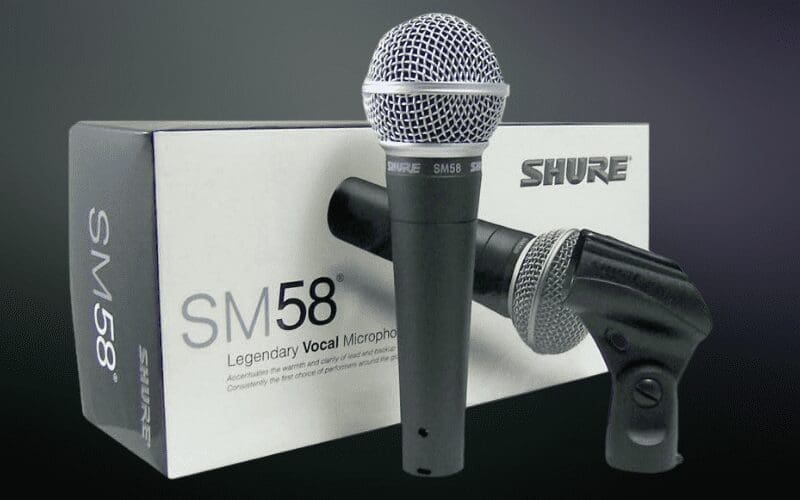
It’s not necessarily because it’s ‘the best’ microphone in the world. What it is is a solid balance of affordability, durability, and quality.
Where the SM58 excels is that, for just £89, you get a microphone that can take years of drops, knocks and spilled pints and still have enough life left in it to represent your vocals cleanly night after night.
Even established pros that have a different favourite mic keep one of these in their bag in case their twice as expensive, half as durable Super 55 lets them down on the night. Let’s take a closer look at what makes this thing a world-renowned gigging machine.
What Is The Shure SM 58?

The Shure SM 58 is an industry-standard, highly versatile cardioid dynamic vocal microphone, tailored to deliver warm and clear vocal reproduction.
Who Are Shure?

Shure has consistently been at the forefront of innovation in the audio industry for almost a hundred years.
During that time, they have been market leaders in the supply of radios and phonographs as well as suppliers of high-grade audio equipment to the US military.
Several of their microphones, including the SM58, are recognised as staples in recording studios, radio booths, and on stages everywhere.
Specifications Of The Shure SM58 Microphone

In this section, we’re going to break down some of the specifications of the Shure SM 58. Starting with the mic type.
Mic Type
The SM58 is a dynamic microphone, as opposed to a condenser. A dynamic microphone is a simple but rugged mic design that has a diaphragm sitting between two magnets.
When sounds cause the diaphragm to vibrate, the magnets convert this movement into an electrical signal. With a condenser mic, a much thinner diaphragm is used and an electrical current is required to make it vibrate. This means it can pick up much more delicate sounds with greater accuracy.
On the face of it you’d think “Oh, condensers are more accurate mics? Why wouldn’t I want that on stage instead?” The reason is that that sensitivity is naturally traded off with fragility and a vulnerability to feedback. The loud environments, constant movement, and likelihood of it taking a few knocks mean that most condenser mics wouldn’t make it past the first gig. If they did, they’d be so sensitive to the noise that you’d be battling feedback all night.
Condensers are great for the studio but can be quite horrible live. Dynamic microphones may lose a little bit of the sparkle that you get with a condenser. But, it’s not something you miss in a live performance and trading that off for a microphone with a more durable diaphragm is a no-brainer. Ironically the ‘SM’ in SM58 stands for ‘Studio Microphone,’ despite it being better suited for live applications!
Pattern
The SM 58 picks up sound in a cardioid pattern. What this means is that it is very sensitive to sounds directly in front of it. As well as slightly sensitive to sounds from the side, and not at all sensitive to sounds from the rear. Thus allowing you to position your mic in a way that stops it picking up noise from speakers or other instruments. This gives you a clear and direct representation of just the sound you want to hear.
Other microphone patterns exist, but the more sound a microphone picks up from the back and the sides the more likely it is that, in a live environment, the sound of the speakers and monitors will be picked up by the microphone. Which is then amplified by the speakers and picked up by the microphone.
Frequency Range
The SM58 microphone has a frequency range of 50hz-15khz. All you need to know here is that the human voice range is approximately 125hz-8khz. Meaning the SM58 has more than enough headroom to pick up all the nuances of booming bass singers and glass-shattering sopranos alike.
Output Impedence
150 ohms – this is pretty standard for any vocal microphone and not something you need to give much consideration to. Unless you’re running a 50-meter cable!
Sensitivity
The sensitivity of the Shure SM 58 is rated at -56.0 dBV. Meaning that standard tests it requires 56 decibels to produce one volt of power. In mic sensitivity, the closer the number is to zero the more sensitive it is. Far more sensitive mics than the SM58 are available. But bear in mind that increased sensitivity is not always desirable.
On stage, a more sensitive microphone is more likely to pick up unwanted sound from other sound sources. The SM58 is designed to favour a nearby sound source without picking up too much interference from other instruments (or hecklers).
Construction
The body of the Shure 58 microphone is made of die-cast metal. Along with a steel mesh grille that effectively works to reduce the pops and esses of hard consonants.
This, coupled with its unique internal suspension system that houses the capsule in a balloon, means that the SM58 is incredibly durable and not particularly sensitive to handling noise. The SM58 is designed to work every bit as well as a handheld mic as it does in a stand.
Connection & Compatibility

The SM58 uses a three-pin XLR connection as standard. This is compatible with most PA systems worldwide and carries a more balanced and high quality signal than jack cables.
Should your PA system only take ¼ inch jack inputs, XLR to jack leads are available from most music retailers. You should expect a reduction in sound quality if using this method of connection.
Features
In terms of features, this mic generally keeps it pretty simple. The only one of note is that you have the option to buy it with an on/off switch. There are a few reasons why you should avoid this addition. Firstly, it’s largely unnecessary.
Most mixing desks have a mute button, and the only time anyone uses the inbuilt switch is to turn the mic on when they forgot their mic had a switch and it was accidentally turned off. Secondly, it’s a moving part, and as such is prone to failure. Thirdly, it costs slightly more. Why add an extra £10 to the price for something you’ll never use!?
Pros Of The Shure SM 58

To help decide if the Shure SM 58 is the right microphone for you, let’s go over the pros.
Durability
Shure really aren’t kidding about the robust design of the SM58. The photo above is of a used Shure SM58 microphone that has seen an average of about fifty gigs a year since 2010. There’s a tiny bit of rust starting to form on the end of the grille. But otherwise, the casing barely has a scratch on it.
Its sound hasn’t changed noticeably and the XLR connection has held up nicely. So, there are no crackles or pops when it’s moved around. If that’s not enough, there are some hilarious videos available online of people using the SM58 as a hammer. Such as setting it on fire, freezing it, running it over with trucks, and then recording vocals with it. Spoiler alert: It works just fine every time. Of course, we don’t recommend trying it for yourself though!
Versatility
Whilst most recording engineers would typically use a condenser mic in the studio, the SM58 is absolutely fine for recording vocals. U2 recorded two albums with an SM58 for Bono’s vocals. Moreover, the Rolling Stones and Billy Idol have used it in the studio too.
It doesn’t have the same level of precision as a condenser mic does. But for some styles of music that may be a positive.
The SM58 also contains a near-identical internal construction to its sister mic the SM57. The SM57 is typically used to capture the sound of instruments due to the shape of its head. It is every bit as popular with musicians as the 58 mic is with singers.
But if you position it well, the SM58 will do a perfectly good job of capturing instrumental audio. It’s not the ideal microphone for every scenario. But if you can only afford to buy one microphone to do everything you can’t go far wrong with the Shure SM58.
Reasonably Priced
When you bear in mind that this is a microphone that every single rock and pop star you’ve ever heard of has sung into, the fact that you can get an SM58 brand new for just £89 is mind-boggling!
There are some deals to be had on the second-hand market too of course. But this is one of the most copied mics in the world. So, be careful who you’re buying from and don’t believe any of those ‘too good to be true’ prices either.
Cons Of The Shure SM58
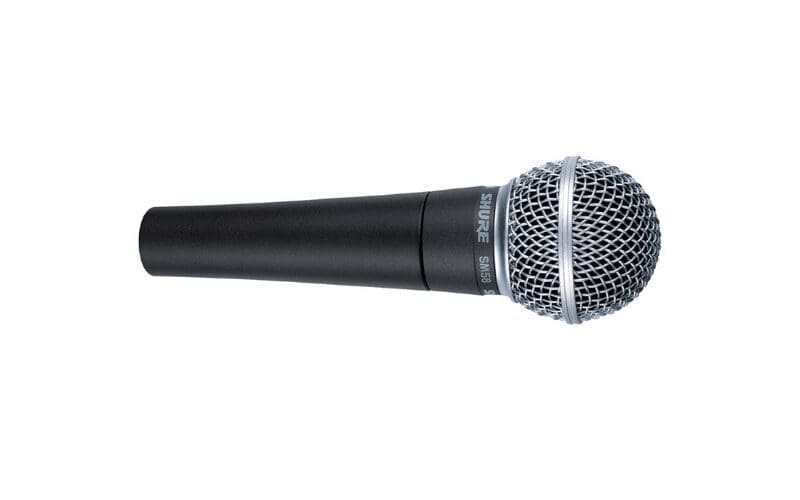
To help decide if the Shure SM58 is the right microphone for you, let’s go over the cons.
Lacks Finesse
The only notable downside with this mic is that, with a design that hasn’t changed much in over fifty years, it is no longer the most precise live microphone available on the market. One common complaint is that the SM58 mic has a tendency to be slightly ‘woolly’ when a singer gets too close to it. This is due to the proximity effect you get when the singer’s mouth is almost touching the mic.
The proximity effect is present in all directional microphones. But the EQ profile of the SM58 means that the diction of some words is easily lost here. Especially if you are speaking or singing loudly.
A good position to try is having your mouth just within the 15cm proximity effect range to get a slight bass lift, but with enough clarity that words are not lost.
Shure SM58 Alternatives
Many alternatives to the Shure SM 58 are available, so let’s take a look to help you decide if it’s the right microphone for you.
Shure Beta 58A

With Shure being one of the industry’s biggest players it’s unsurprising that the biggest competitor to the Shure SM58 is another Shure mic.
The Beta 58a features a series of improvements over the SM58. Including a super-cardioid pickup pattern that reduces the likelihood for feedback on stage. As well as an improved internal shock mount to further reduce handling noise, a slightly higher output volume and an extended frequency range for greater detail.
Whilst that sounds like a big deal, it also costs almost 50% more than a Shure SM58, coming in at around £138. For the difference in price those improvements are quite minor, and won’t necessarily be noticeable to many users.
Additionally, if you do a lot of shouting and screaming, you may even find the extra sensitivity to be a little too hard to navigate. If you don’t mind spending a bit extra, and you know you’re going to get the use out of it, the Beta 58a may be worth your consideration. But, it’s a big jump in price for a smaller step up in quality.
Sennheiser e935/e945
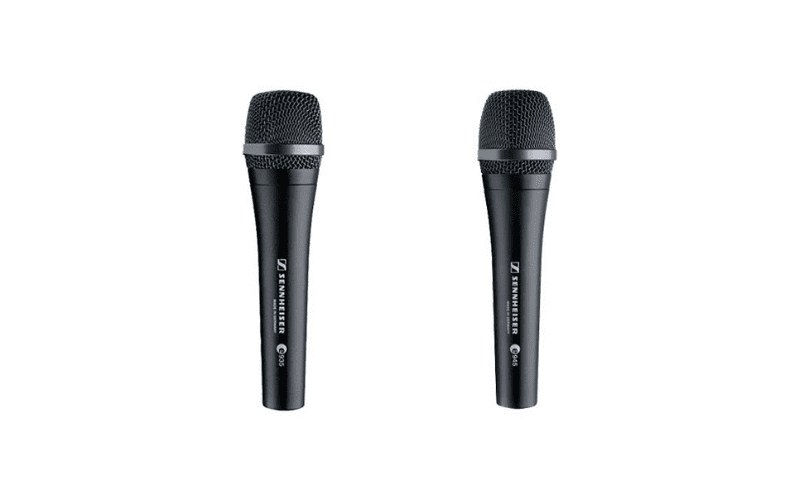
These two microphones are close to identical, with the main difference being that the 935 is cardioid and the 945 is super-cardioid. The e935 comes in at around £100. With the e945 priced closer to £170.
The Sennheiser is arguably a more balanced microphone. With a flatter EQ and a wider frequency range than the SM58. Some people find this not to their taste as the SM58 is so ubiquitous that its characteristic tone has become synonymous with how we think good stage vocals should sound. We’d encourage you to give this one a try, and have a go at reducing the mids. Rather than boosting the bass, on your PA system’s EQ.
As a challenge to Shure’s dominance as the makers of the most durable stage microphone, Sennheiser also offer a ten year warranty on this mic. If you don’t love the SM58, this may be the one for you!
SE V7
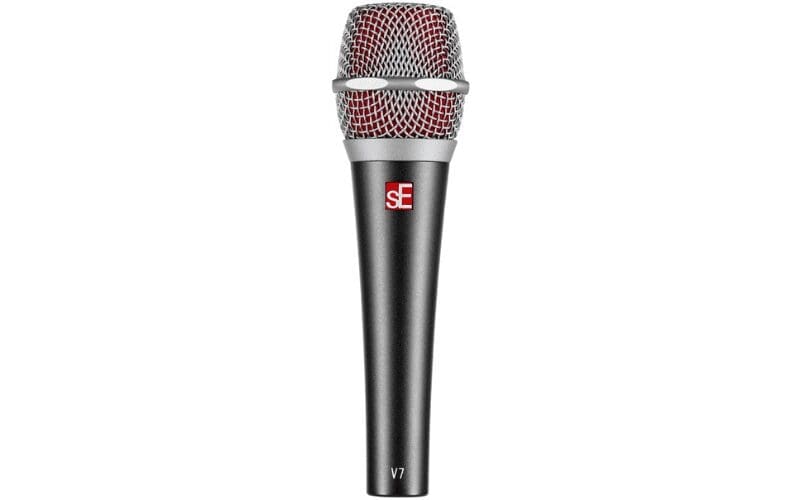
This is a wonderfully priced alternative that comes with a super cardioid pattern as standard for excellent side-noise rejection. At £72 this microphone is absolutely worthy of your attention.
It has a frequency response of 40hz-19khz, a similar frequency response to the SM58, and it’s got a really attractive look to it as well!
Depending on your voice you may find that this one really suits you. Give it a try.
That Was Our Shure SM 58 Review
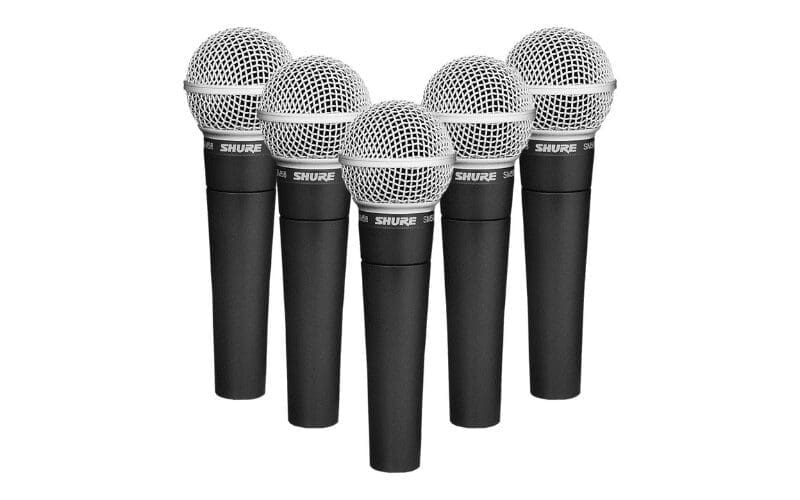
This mic has been tried and tested by pretty much every musician for the last fifty years with very few complaints. If this is going to be your first microphone then, even if you upgrade years later, it’ll always be there for you as a reliable backup.
Having said that, other manufacturers are starting to chip away at the SM58’s reputation. There’s a feeling among many sound engineers that it’s partly coasting by on a combination of sentiment, inertia and an attempt to recapture the tone of all the great singers that have used it before. It’s getting harder every year to make the argument that it’s still the best vocal mic around. Overall it’s definitely worth a look. But in a blind test, many singers would end up preferring the sound of a Sennheiser or a Beta 58.
Whether you go for this or one of the alternatives all depends on your voice of course, so we’d always recommend getting yourself somewhere where you can test one out. But the great thing about these microphones is that they are absolutely everywhere; so just go to your local open mic night, get up on stage and we guarantee you that you’ll find yourself in good company, staring down the barrel of a Shure SM58.
Are You A Musician Or Artist?
Do you want to learn more about music gear and further your education? Then check out the Academy. Our courses are designed to give you skills that are valuable to you as an artist. Whether you’re looking to learn a new instrument, understand how to use a specific DAW or want to get better at songwriting, we’ve got a course for you!
By joining Мusic Gateway, you can also collaborate globally with other musicians, songwriters producers and more. Finally, amplify your music to those that need to hear it with music promotion and professional sharing tools. Get your 14-day free trial, no strings attached.










